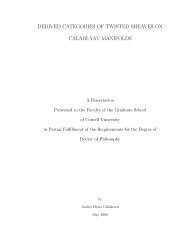A Course on Large Deviations with an Introduction to Gibbs Measures.
A Course on Large Deviations with an Introduction to Gibbs Measures.
A Course on Large Deviations with an Introduction to Gibbs Measures.
Create successful ePaper yourself
Turn your PDF publications into a flip-book with our unique Google optimized e-Paper software.
2.2. Formal large deviati<strong>on</strong>s 13<br />
We are interested in the weight µn assigns <strong>to</strong> <strong>an</strong> outcome x ∈ X . In<br />
Example 1.1 these weights decayed like e −cn for atypical points. This is the<br />
kind of situati<strong>on</strong> we w<strong>an</strong>t <strong>to</strong> study, <strong>an</strong>d in particular we wish <strong>to</strong> compute the<br />
c<strong>on</strong>st<strong>an</strong>t c exactly. It could happen that c is infinite. This either happens<br />
because x c<strong>an</strong> never take place or because the probability actually decays<br />
faster th<strong>an</strong> exp<strong>on</strong>entially. On the other h<strong>an</strong>d, c could also be 0 which me<strong>an</strong>s<br />
that x turns out <strong>to</strong> be “less rare” th<strong>an</strong> we thought <strong>an</strong>d the probability decays<br />
slower th<strong>an</strong> exp<strong>on</strong>entially. Looking for the correct rate of decay is thus part<br />
of the problem. Let us say then that, at scale rn ↗ ∞, the weight µn assigns<br />
<strong>to</strong> x decays like e −crn . We still would like <strong>to</strong> compute the c<strong>on</strong>st<strong>an</strong>t c. In<br />
fact, this is a functi<strong>on</strong> of x that we will call the rate functi<strong>on</strong> <strong>an</strong>d denote by<br />
I(x).<br />
This is of course not precise. Often we c<strong>an</strong>not talk about the weights<br />
assigned <strong>to</strong> individual elements x of the space. Instead we must talk about<br />
weights assigned <strong>to</strong> events, or subsets, of the space. But, thinking informally<br />
for just a bit l<strong>on</strong>ger, <strong>on</strong> <strong>an</strong> exp<strong>on</strong>ential scale it makes sense <strong>to</strong> regard <strong>an</strong> event<br />
A as rare as its least rare outcome. That is, the weight assigned <strong>to</strong> a set A<br />
should be the maximal weight µn assigns <strong>to</strong> <strong>an</strong> element of A, i.e. e −rn infA I .<br />
On a technical level, it is <strong>to</strong>o much <strong>to</strong> expect actual c<strong>on</strong>vergence for all sets<br />
A <strong>on</strong> account of boundary effects. A more reas<strong>on</strong>able formulati<strong>on</strong> would be<br />
<strong>to</strong> say that for all measurable sets A:<br />
(2.1)<br />
− inf I(x) ≤ lim<br />
x∈A◦ n→∞<br />
1<br />
rn<br />
log µn(A) ≤ lim<br />
n→∞<br />
1<br />
rn<br />
log µn(A) ≤ − inf I(x),<br />
x∈A<br />
where A ◦ <strong>an</strong>d A are, respectively, the <strong>to</strong>pological interior <strong>an</strong>d closure of A.<br />
Remark 2.2. The limsup for closed sets <strong>an</strong>d liminf for open sets remind<br />
us of weak c<strong>on</strong>vergence of probability measures where the same boundary<br />
issue arises; see Appendix A.1 for the definiti<strong>on</strong> of weak c<strong>on</strong>vergence.<br />
Example 2.3. Let us revisit the Bernoulli i.i.d. sequence {Xn} that we<br />
c<strong>on</strong>sidered in Example 1.1. If we let µn(A) = P {Sn/n ∈ A} <strong>an</strong>d recall the<br />
functi<strong>on</strong> Ip in (1.1), then {µn} satisfy (2.1) <strong>with</strong> normalizati<strong>on</strong> n <strong>an</strong>d rate Ip.<br />
Indeed, take first <strong>an</strong> open set G. For <strong>an</strong>y point s ∈ G ∩ [0, 1] taking n large<br />
enough implies that [ns]/n ∈ G <strong>an</strong>d thus P {Sn/n ∈ G} ≥ P {Sn = [ns]}.<br />
This implies that<br />
1<br />
lim<br />
n→∞ n log P {Sn/n ∈ G} ≥ lim<br />
n→∞ P {Sn = [ns]} = −Ip(s).<br />
This inequality also holds for s ∈ G [0, 1], since Ip(s) is infinite then. Now<br />
we c<strong>an</strong> take sup over points s ∈ G <strong>an</strong>d the lower bound in (2.1) follows by<br />
taking G = A ◦ .
















